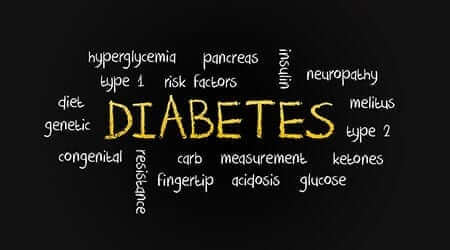There a few types of diabetes including LADA but the two main ones are diabetes type 1 and type 2. Both require ongoing monitoring and maintenance. There are similarities including the need to control blood glucose levels, but there are several differences between type 1 and type 2 diabetes as well.
- Type 1 diabetes may also be referred to as insulin-dependent diabetes. Only 5 to 10 percent of people are diagnosed with type 1. Type 2 diabetes is frequently called non-insulin-dependent diabetes. Up to 95 out of 100 people with diabetes have type 2.
- In type 1 diabetes, it is thought that the body’s immune system destroys the cells that release insulin. Eventually this eliminates insulin product. Without insulin, cells are unable to absorb sugar to produce energy. In diabetes type 2, there may be reduced insulin but mostly the body is insulin resistant. This means the body has insulin but can’t use it correctly. The longer the condition exists may lead the pancreas to make less insulin. This is called insulin deficiency. While people with type 1 diabetes have a total lack of insulin, people with type 2 may have too little insulin or just can’t use it effectively.
- The symptoms of type 1 diabetes usually start during childhood or adolescence but the disease can occur at any age. Symptoms may include headaches, thirstiness, blurry vision, fatigue, lack of focus, and blood sugars more than 180 mg/dl. Most people feel sick from the symptoms and seek medical help. They tend to lose a great deal of weight without trying in a short period of time. Conversely, many people with type 2 diabetes may have few or no symptoms prior to diagnosis. Diabetes type 2 is usually discovered in adulthood after the age of 40. An increasing number of children are now being diagnosed with type 2 diabetes due to poor eating habits, increased weight, and lack of activity.
- At this point in time type 1 diabetes cannot be prevented or cured. People must take insulin to lead active, healthy lives. Type 2 diabetes may be prevented or delayed by making healthy lifestyle changes such as maintaining a healthy weight, exercising at least 30 minutes a day and eating the proper diet including lean meats and fish, low-fat dairy, whole grains and fruits and vegetables. Insulin and/or certain medications might be prescribed for people with type 2 diabetes but that is not always the case. People with diabetes type 2 do not become type 1 when placed on insulin.
- People with type 1 diabetes may have frequent episodes of low blood sugar referred to as hypoglycemia. Those with diabetes type 2 diabetes may never experience episodes of low blood sugar unless they are taking certain oral diabetes medications or insulin.
- Little is still known about the risk factors for diabetes type 1. Some possibilities include genetics, family history, and exposure to certain viruses such as Epstein-Barr. People who are inactive and overweight have a higher risk of developing type 2 diabetes. Other risk factors for type 2 include family history and race. Asian Americans, African-Americans, American Indians, and Hispanics have a higher risk of developing diabetes type 2.
- People with both types of diabetes are at risk of certain health complications including kidney disease and heart disease. It is important to treat blood glucose levels and address cholesterol and blood pressure levels. Using a blood pressure monitor at home and reporting the results to your health care team can help determine if you are having problems that should be addressed.
The key to living a quality life with diabetes type 1 or type 2 is to get immediate medical attention and control. Your health care team will advise you about medications, lifestyle changes, and other things which can be done to ensure your health. With the right care and treatment you can continue to have an active and satisfying life with type 1 or type 2 diabetes.







Leave A Comment